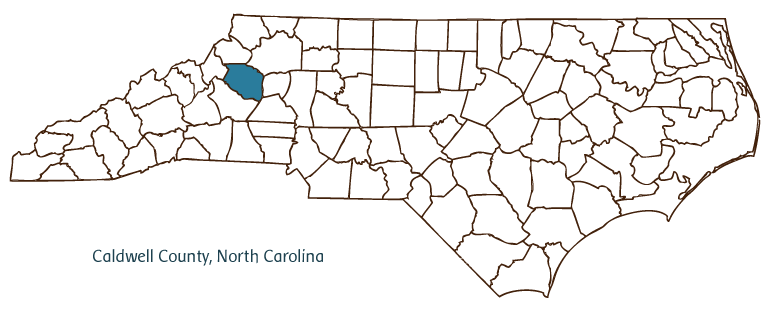Caldwell County Resources
- View All:
- Biographies
- Monuments
- locations
Copyright Notice: This article is from the Encyclopedia of North Carolina edited by William S. Powell. Copyright © 2006 by the University of North Carolina Press. Used by permission of the publisher. For personal use and not for further distribution. Please submit permission requests for other use directly to the publisher.

Caldwell County, located in the Mountain region of western North Carolina, was formed from Burke and Wilkes Counties in 1841. It was named for Joseph Caldwell, the first president of the University of North Carolina in Chapel Hill. Early inhabitants of Caldwell County included Cherokee and Siouan Indians, followed by German, Scotch-Irish, and English settlers. The county seat, Lenoir, was incorporated in 1851 and named for Revolutionary War general William Lenoir. Other communities in Caldwell County include Hudson, Granite Falls, Rhodhiss (on the Burke County line), Cajah Mountain, and Gamewell. Part of Blowing Rock is also in Caldwell County.
The mountainous terrain attracts thousands of tourists to Caldwell County each year, and a large portion of the county is covered by the Blue Ridge Mountains and Pisgah National Forest. The Catawba, Yadkin, and Little Rivers flow through the county.
Caldwell County is one of the leading producers of furniture in the world. Other manufactured products include labels and tape, twines, yarn, and thread and cordage. Agricultural products from Caldwell County include broilers, hatching eggs, hay, soybeans, oats, barley, and landscape nursery plants.
Historic sites in Caldwell County include the county courthouse, constructed in 1905; Fort Defiance (1790), the home of General Lenoir; the Eli Corpening House, built in 1856; and Little House, built in 1872. Cultural institutions include the Foothills Performing Arts Community Theatre, the Unifour Jazz Ensemble, and the Caldwell County Heritage Museum. The Overmountain Victory National Historic Trail traverses the county. In 2004 the population of Caldwell County was estimated to be 78,500.
For an annotated history of the county's formation, with the laws affecting the county, boundary lines and changes, and other origin information, visit these references in The Formation of the North Carolina Counties (Corbitt, 2000), available online at North Carolina Digital Collections (note, there may be additional items of interest for the county not listed here):
County formation history: https://digital.ncdcr.gov/Documents/Detail/the-formation-of-the-north-ca...
Index entry for the county: https://digital.ncdcr.gov/Documents/Detail/the-formation-of-the-north-ca...
Additional resources:
Corbitt, David Leroy. 2000. The formation of the North Carolina counties, 1663-1943. https://digital.ncdcr.gov/Documents/Detail/the-formation-of-the-north-carolina-counties-1663-1943/3692099?item=4553233 (accessed June 20, 2017).
Caldwell County Government: https://www.caldwellcountync.org/
Caldwell County Chamber of Commerce: https://www.caldwellchambernc.com/
DigitalNC, Caldwell County: https://www.digitalnc.org/counties/caldwell-county/
North Carolina Digital Collections (explore by place, time period, format): https://digital.ncdcr.gov
Image credits:
Rudersdorf, Amy. 2010. "NC County Maps." Government & Heritage Library, State Library of North Carolina.
Mazzocchi, Jay. "Caldwell County." NCpedia. State Library of NC. 2006. https://www.ncpedia.org/geography/caldwell.